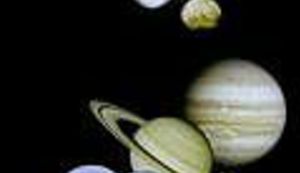
Top 10 svemirskih misterija
Nakon što smo u uvodu ove novice najavili kako ćemo napraviti iznimku i na čitanje vam ponuditi vijest u kojoj neće biti nimalo lupeške osobnosti kao što smo to navikli do sada, još jednom ćemo vas iznenaditi i dati vam da čitate na nekom drugom jeziku, točnije na engleskom. Budući da je vijest duga i zbog toga nemam volje prevoditi je, ostavit ću je onakvu kakvu sam je našao na Space.com. Smatram kako je to sasvim pohvalno od mene, jer tako vam dajem priliku da malo vježbate svoj engleski. Dakle, sada vas ostavljam same u svemiru sa izvorom života, sunčevim sustavom, mračnom energijom, nestalim planetima, vodom na Marsu i pitanjem koje nam je postavio i Edo Maajka u svojoj ponajboljoj pjesmi - Jesmo li sami?
The funny thing about discoveries is that they often produce new mysteries, too. This year was no exception, as many remarkable space science findings generated puzzling problems for astronomers to look into.
In some cases the puzzles are brand new. Other times a discovery merely confirms how little we knew. Either way, there's plenty for astronomers to do.
Here then are the Top 10 Space Mysteries that astronomers will be pondering in the New Year and beyond.
1. Dark Energy
Nobody knows what the heck it is, but it is officially repulsive. And man is it powerful! More powerful than gravity, even.
While gravity holds things together at the local level (and by local I mean within galaxies and even between them, forming galactic clusters) some unknown force is working behind the scenes and across the universe to pull everything apart. Scientists have only come to realize this dark force in recent years, by discovering that the universe is expanding at an ever-increasing pace.
Having no clue what it is, they've labeled it dark energy.
The past year was a good one for proving that dark energy is at work. Calculations have been refined: The repulsive force dominates the universe, comprising 65 percent of its makeup.
(Similarly unseen and exotic dark matter makes up 30 percent of the universe, leaving us with a universe that contains just 5 percent normal matter and energy.)
Two curious ideas related to the accelerating expansion, both of which emerged in 2002: All galaxies are destined to become frozen in time or, perhaps, time never ends.
2. Water on Mars?
Mars simply will not give up its most coveted secrets. Ultimately, the big quest for NASA (news - web sites) and all the Mars scientists is about whether there is life, but before that's answered, there is the question of liquid water, a requirement of life as we know it.
Despite two major discoveries of water ice in 2002, nobody can figure out yet whether any of it might exist in the melted state.
Meanwhile, clues mount. In one compelling study released in December, dark streaks on the surface were attributed to salty, running water. But many experts remain unconvinced. NASA's Odyssey spacecraft is circling Mars as you read this, hunting for more evidence.
3. The Murky, Mediocre Middle of the Milky Way
Something is eating at the black hole at the center of our galaxy. And whatever is bugging the gravity monster manifests as an utter lack of appetite.
In October, astronomers announced they'd watched a star zip around the black hole that anchors the Milky Way, all but proving the impossible-to-see object is actually there. Meanwhile, the region around the black hole is an active place, as the Chandra X-ray Observatory showed early this year.
However, the black hole is not devouring enough matter to generate the tremendous X-ray output seen with other supermassive black holes. Scientists are so far unable to fully explain the stark contrasts they've seen, this tremendous diversity in black hole behavior.
Hints emerged this year, however. A study in January suggested mergers between two black holes might serve as an on-off switch for the activity. Then observations announced in November showed two black holes involved in a pending merger. Astronomers now need to tie all this to a firm explanation of the differences between the mediocre output of our black hole and the brilliant illumination surrounding others in many distant galaxies.
4. The Origin of Life
Have you ever had one of those dreams where you try to run from a monster and you're legs go 'round and 'round but you don't get anywhere? The quest to understand the origin of life isn't much different.
In fairness, it must be pointed out that there is little data to work with. Earth does not retain a record of what went on billions of years ago, when life got going.
Meanwhile, there is no shortage of wild ideas. Scientists now generally agree that life could survive a trip to Earth from Mars, in the belly of a rock kicked up by an asteroid impact. A study in November revealed why a Mars rock lands on Earth once a month, on average. A wilder idea, that bugs simply rain down from space inside comet dust, gained support from a second scientist in December, who claimed to have found some of these space bugs in Earth's atmosphere.
Most mainstream scientists, however, figure there's a good chance that life on Earth was cooked up in a soup of pre-biotic chemicals right here on the planet. The ingredients -- water and organic chemicals -- may well have come from space, but Earth likely acted as the incubator.
The answer (and a lot of well-funded researchers are asking the question and debating the possibilities) bears on how likely it is that life might have begun elsewhere, on Mars or around another star.
5. Lunar Secrets
No place beyond Earth is more well studied than the Moon. We went there, stomped around. Sifted the soil. Brought some rocks back. But the Moon still holds many secrets. The most profound might be rocks launched from Earth billions of years ago by asteroid impacts.
These storehouses of terrestrial information have been presumed for years to exist on the Moon; this July an attempt was made to quantify them. The estimate: 11,000 pounds of Earth stuff sits within a few inches of the surface for every square mile on the Moon.
The rocks should hold information about the composition of the young Earth and its atmosphere, and possibly even the origin of life. This information is not available anywhere else because, unlike the Moon, Earth continually recycles its surface material, folding it inward and melting it beyond recognition.
Nobody can say for certain this stuff is there, or whether it can be retrieved, but researchers are optimistic.
"This [new study] gives us a compelling reason to go back -- to look at the Moon as a window to early Earth," said study leader John Armstrong of the University of Washington. He added that it would be the fastest and cheapest way to learn about planet's early years and the formation of the whole solar system.
6. Are We Alone?
If only we could click our heels and be swept off to another Earth, we'd know. Meanwhile, we're all stuck here on this planet with arguably lousy cosmic eyesight, forced to indirectly detect the presence of worlds around other stars, left to wonder if they might harbor life.
So far the worlds we find are huge, most bigger than Jupiter. Prior to 2002, every one of them orbited so close to its host star as to be decidedly strange by the standards of our solar system. This forced us to question whether ours is standard at all.
In June, however, new "Jupiters" were found in orbits similar to our own beloved gas giant.
Now the pressure is on to find smaller planets, and one study this year estimated there are billions of them out there. Few doubt the presence of at least some rocky planets in Earth-like orbits. But don't bet on any proof coming 2003. This is a mystery that probably won't be solved until a new generation of space telescopes goes into orbit, mid-decade at the soonest.
Meanwhile, another study this year estimated the chances for extraterrestrial life on Earth-like planets is 1-in-3.
Most scientists, when they talk about ET, would be thrilled to find microbes. The folks over at the SETI Institute, on the other hand, are listening for intelligent life, perhaps animals like us (or really smart microbes). While they may never get a signal, it could happen in 2003.
7. The Enigmatic Sun
If you're looking for a career with a really bright future, become a solar physicist. Amazingly, we still don't fully understand the dynamics of the star we orbit.
New pictures of sunspots in 2002, the most detailed ever, revealed canal-like structures reaching from bright regions into the dark hearts of sunspots. The strange structures are fueled by the Sun's tremendous heat and magnetic energy, but beyond that, their generation is a mystery.
"Exactly what happens and why these kind of structures are formed, we don't know," said study member Dan Kiselman.
And the Sun in general? "The amazing zoo of structures and dynamic phenomena on the Sun are not well understood in general, though they have been observed for a very long time," Kiselman said. Sounds like serious job security.
8. Age of the Universe
Scientists pretty much agree on the general method by which the early universe evolved. But they start to argue when the topic of the universe's actual age comes up.
The age of the universe has been put at 12 billion to 15 billion years for some time now, but every few months a revision or refinement is announced. Hubble Telescope observations yielded in April an estimate of 13-14 billion years.
We can't say when a firm answer will be presented, but we can predict the likelihood of another estimate sometime in 2003.
(A related and even more vexing set of questions: What exactly happened at the beginning of the universe, and what existed before that instant? These are questions cosmologists will likely wrangle with forever, since no direct observations can be made of those time frames and therefore, presumably, no proof can come.)
9. Missing Planets
Imagine the surprise of a really smart scientist who runs the latest computer model, loaded with a decades-old, widely accepted theory about how our solar system formed, and the computer spits out a diagram with only seven planets.
Uranus and Neptune have been missing, in theory, for some time now. The problem arises because the standard model of planet formation requires material to crash together and stick over millions of years. Once a large core is built, gas can be attracted to create planets like Jupiter and Saturn. But out where Neptune and Uranus roam, there would never have been enough hard material for this to work.
This year, theorist Alan Boss of the Carnegie Institution of Washington put forth a radical new idea, a planet-formation mechanism that conveniently builds the two outer ice giants, too. Boss figures the four big planets in our solar system did not develop from rocky cores, as the standard model once held, but that they collapsed from large gas and dust clouds.
To round out his theory, and the planets, Boss had to put our fledgling solar system in another part of space. He chose a region of intense star formation, so that the UV radiation from a nearby star could strip Uranus and Neptune down to fighting weight. The solar system then migrated to its present, more pleasant region of the galaxy.
All well and good, but other astronomers are very skeptical. We're left with an old theory that doesn't work and a new one that is, in the words of its creator, a wild idea.
Maybe in 2003, while some scientists are busy looking for planets around other stars, someone will figure out for sure how the planets in our own solar system were created!
10. Can We Survive 2003?
No space news made for more dramatic headlines in 2002 than the seemingly imminent risk of asteroid impacts. Over and over.
In the most celebrated case, an asteroid with a tiny chance of hitting Earth in the year 2019 was overhyped by the media in July, only to have the odds downgraded days later. The scenario is one that seems to repeat at least once a year.
For now, there are no space rocks known to be on a collision course with Earth. At the same time, there are tons of them out there that have not been found. Particularly taxing for astronomers will be the small objects, which roam space by the millions, could devastate a region of the planet, and all of which probably won't be catalogued for decades to come, if ever.
Meanwhile, asteroids continue to present new puzzles that make it difficult to imagine what to do with one that might be headed our way. Some seem to be relatively solid chunks of stone or metal. Others appear to be rubble piles, loosely bound smaller rocks. Blowing one of these up would have dramatically varying consequences based on the composition of the targeted material.
Importantly, the tally of asteroids with companion moons rose above 30 during 2002. Many other such pairs await discovery. Deflecting or destroying an incoming pair of rocks would present a daunting challenge to engineers who don't yet know how to deal with a lone asteroid.
For those who might worry, odds are good we can survive 2003, at least in terms of the threat from space rocks. And the chances are good that if a big one is coming our way, we'll know about it years if not decades in advance, astronomers say.
The challenge for scientists, however, is to begin a concerted effort to find smaller asteroids and unravel the remaining mysteries of this wildly diverse category of objects and to do so before they find one bearing down on our planet.















